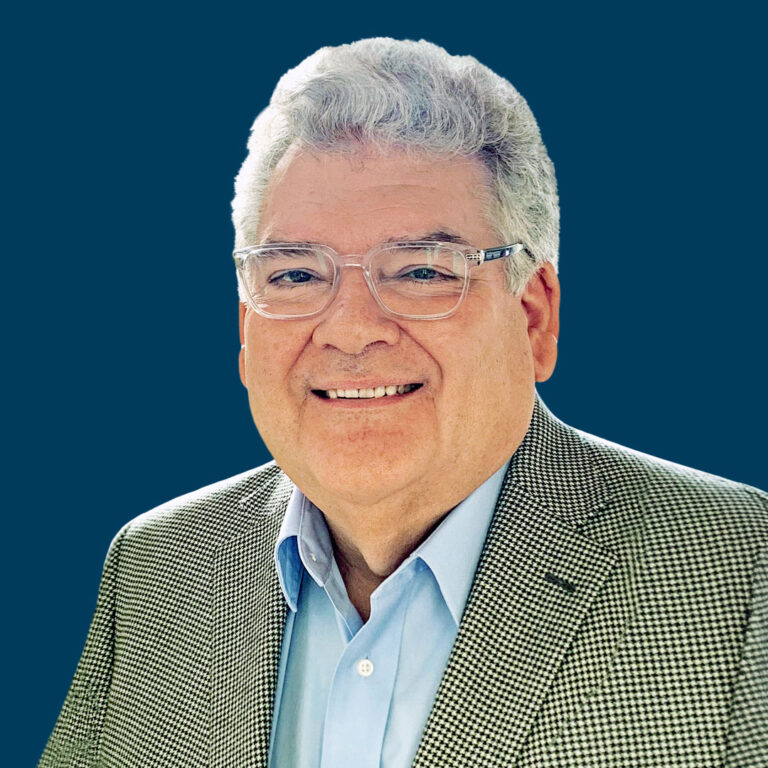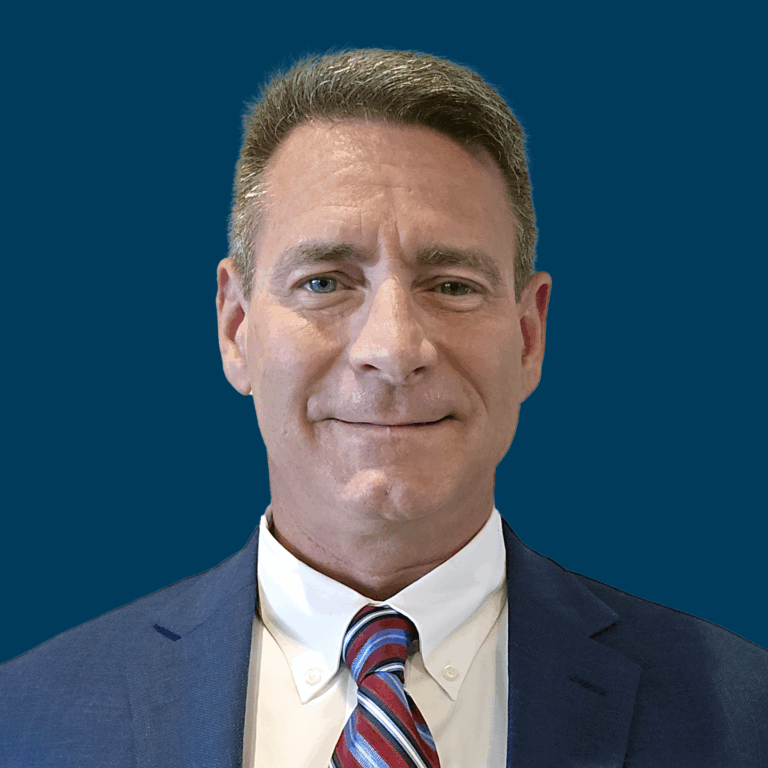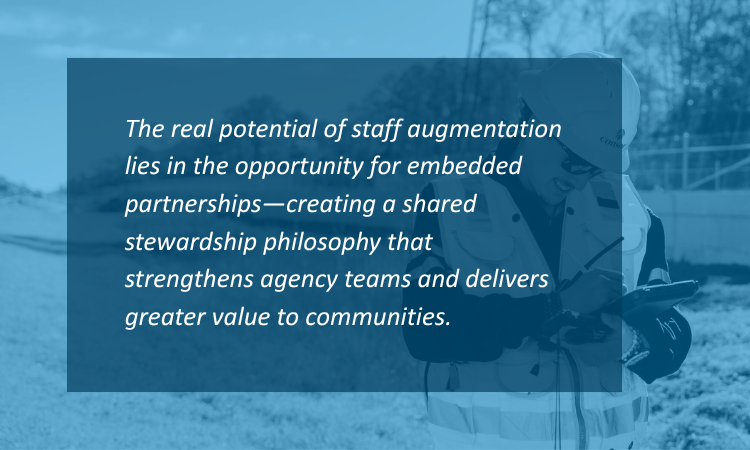
The True Value of Staff Augmentation Is Embedded Partnerships
Infrastructure systems are straining under the dual pressures of population growth and aging assets. This convergence is creating a surge in larger, more complex projects spanning routine maintenance, modernization, and expansion. Infrastructure owners’ capacity to respond is struggling to keep pace.
Enrollment and degree completions in civil engineering have declined in recent years, and projections show fewer students entering the field in the decade ahead. Compounding this talent shortage, nearly a third of today’s infrastructure workforce is approaching retirement, accelerating the loss of institutional knowledge. Public agencies are then competing for the limited talent available with consulting firms, which can often offer more attractive salaries and benefits packages, ultimately leaving critical positions unfilled. At the same time, the funding landscape is increasingly volatile, with billions in grants frozen or delayed, complicating long-term planning and stretching local budgets.
Staff augmentation has become a critical strategy for infrastructure owners to scale quickly, access specialized expertise, and maintain momentum on capital programs.
But its real potential lies in the opportunity for embedded partnerships—creating a shared stewardship philosophy that strengthens agency teams and delivers greater value to communities.
Key Takeaways:
- Infrastructure owners face mounting project demands, workforce shortages, and funding volatility, creating growing reliance on staff augmentation.
- Agencies turn to staff augmentation when capacity falls short, deadlines are critical, funding shifts, specialized expertise is needed, or programs demand sustained management.
- Case study projects demonstrate how staff augmentation takes shape as embedded partnerships, targeted resourcing, and hybrid approaches.
- Augmentation enhances quality, protects schedules and budgets, and strengthens institutional knowledge—with the potential of creating a shared stewardship philosophy.
- The future of staff augmentation will be shaped by embedded partnerships, knowledge sharing, hybrid schedules, and deeper integration of digital tools.
What Staff Augmentation Is—and When to Use It
Staff augmentation places consultant staff under the direction of the agency, using internal processes and systems while providing immediate capacity and specialized expertise. Rather than outsourcing work, infrastructure owners embed consultants into their teams to preserve oversight over priorities, budgets, and standards. Agencies most often turn to staff augmentation:
- When capacity falls short. Workloads may exceed what in-house staff can handle during peak construction seasons, overlapping capital projects, or periods of high vacancy. Augmentation provides a way to sustain delivery without the long lead times of recruitment.
- When funding shifts. Grant pauses, delayed disbursements, or fiscal year budget changes create uncertainty that makes long-term hiring difficult. Augmentation allows owners to scale teams up or down as funding becomes available, keeping projects moving without overcommitting to permanent positions.
- When deadlines are critical. Construction windows, permitting schedules, and funding milestones often require a surge of staff attention within a short time frame. Augmentation enables agencies to align staffing directly with these time-sensitive demands.
- When specialized expertise is needed. Many tasks require skills not always available in-house, such as specialized design knowledge or compliance with evolving DOT requirements. Augmentation allows agencies to bring in the right expertise, often in niche areas, for specific assignments without maintaining permanent staff for roles used only periodically.
- When programs need sustained management. Large capital initiatives often demand consistent leadership across multiple years and project phases. Agencies may not have enough internal program managers with experience in alternative delivery, contractor negotiations, or multi-discipline coordination. By embedding consultants, infrastructure owners gain continuity and leadership capacity that steadies complex programs.
How Agencies Apply Staff Augmentation
Agencies adopt different augmentation models depending on the scale of their programs, the stability of their budgets, and the types of expertise required. These approaches can range from short-term task support to fully embedded, multi-year roles. The following three case studies of Consor supporting agencies with augmentation illustrate these different models.
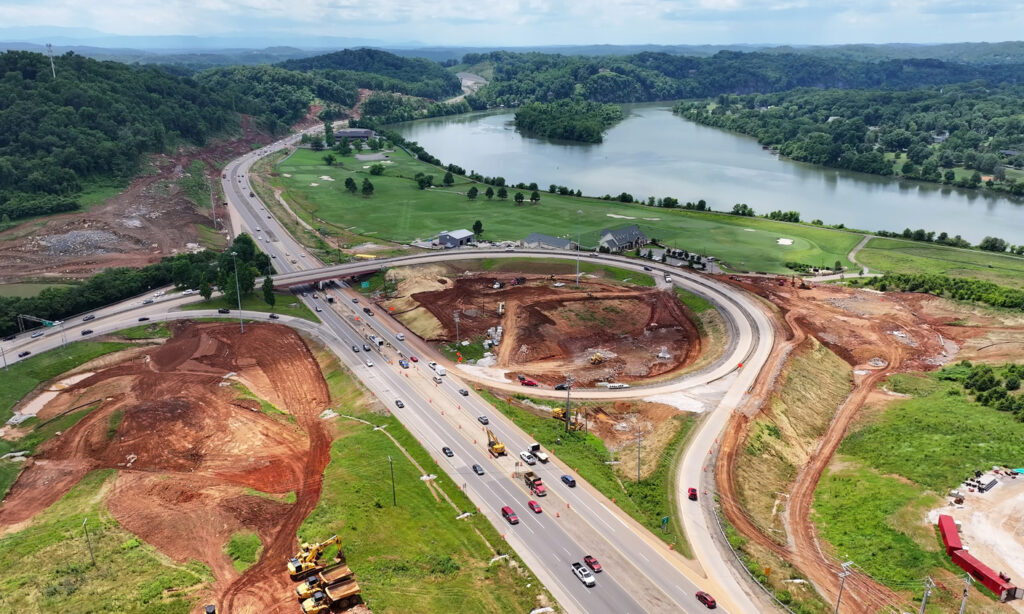
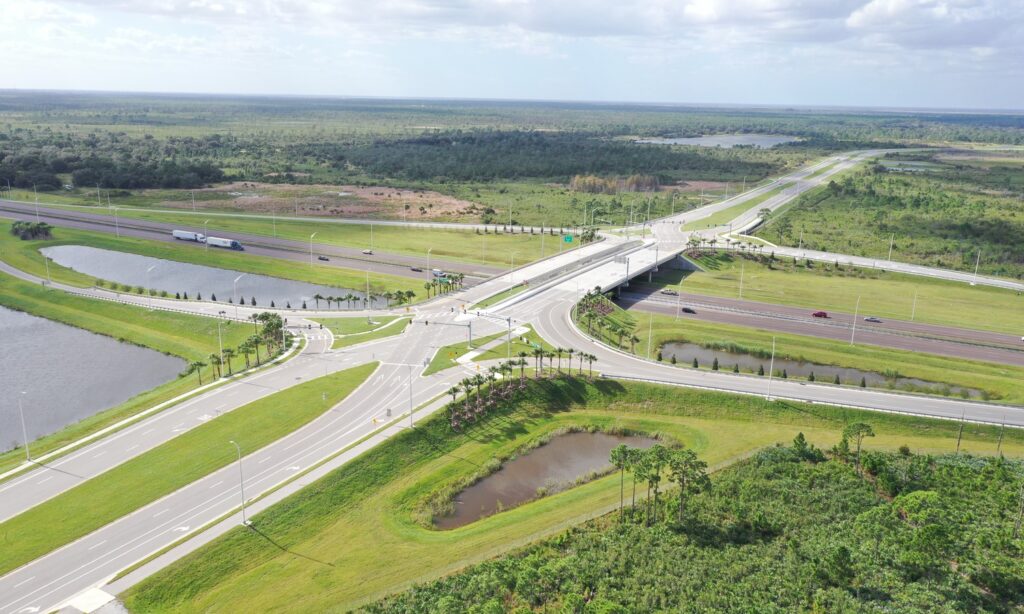

Embedded Program Teams
For large, ongoing capital programs, agencies often embed consultants for multiple years. These roles may include program managers, construction oversight staff, or specialists who provide continuity through changing project phases.
Consor provides staff augmentation services to Tennessee agencies, embedding teammates to expand capacity and manage complex programs. Our teammates support traffic management reviews in the right-of-way permitting office, program management for more than 425 bridges and culverts, stormwater capital improvements, and surveying services for sidewalk and bikeway projects. At another agency, our engineers deliver roadway, signal, and hydraulic design, as well as utility coordination and cost estimating in alignment with agency standards. By acting as embedded partners, our engineers, inspectors, and managers help move projects forward, informed by established processes and priorities. By building trusted working relationships, embedded roles provide continuity and capacity without disrupting agency culture—all while drawing on broader consultant expertise when needed.
Targeted Surge Resourcing
In situations where deadlines, compliance reviews, or funding milestones create temporary peaks in workload, agencies may bring on consultants for highly specific tasks. Examples include plan reviews, quality assurance checks, or support for grant documentation. This model provides a way to meet short-term demands efficiently while keeping internal staff focused on core responsibilities.
Consor provides continuing staff augmentation and consultant services for the Cities of Palm Bay and Kissimmee, integrating directly with City teams to deliver civil, traffic, stormwater, and construction engineering support. In Palm Bay, our teammates manage land development and traffic-related reviews, coordinate permitting, and support roadway, intersection, and drainage improvements under the City’s continuing services contract, which we have held since 2021. Building on this foundation, Consor now serves Kissimmee through similar continuing services contracts, offering project management, plan reviews, and stakeholder coordination. These roles illustrate how a philosophy of embedded partnerships can lead to long-term collaboration. Agency staff remain in the lead, while our teammates contribute capacity and technical depth. The trust developed through day-to-day collaboration has allowed both Cities to leverage consultant colleagues equally invested in their communities’ success
Hybrid Approaches
Some agencies blend long-term embedded roles with task-based surge support. This model maintains continuity in program leadership while flexing staff levels around construction windows, fiscal-year cycles, and phase-specific needs. Agencies keep governance in-house while directing embedded teammates and pulling in additional expertise for defined tasks.
Consor has provided multi-year staff augmentation support for the Colorado Department of Transportation (CDOT), acting as an extension of its staff across a wide range of traffic engineering and program management roles. Our team supports the Region 1 resident engineers on multiple projects through MHT reviews, plan set reviews, work zone deployment verification, project management, inspections, and field visits, enabling CDOT to give contractors and designers high-quality feedback quickly to avoid costly delays. Since 2014, Consor has completed more than 100 tasks under front-range traffic engineering on-call contracts, and our teammates have supported the freight branch with weigh stations, chain stations, and warning systems. This blend of long-term program management and targeted technical support shows the collaborative potential of augmentation—CDOT retains control of programs and priorities, while benefiting from the continuity and surge capacity of an embedded consultant.
The Strategic Value of Staff Augmentation
More than a stopgap for immediate staffing shortages, staff augmentation is a strategic tool that strengthens delivery, safeguards quality, and supports community outcomes. Benefits include:
- Quality assurance and risk reduction. Experienced, embedded consultants bring specialized expertise and proven QA/QC practices that many agencies may not maintain in-house year-round. Their exposure to diverse standards and evolving industry practices allows them to deploy risk-based inspection approaches, identify issues early, and align deliverables with quality requirements. Working alongside agency staff, they help reduce rework, manage risk, and uphold quality expectations the public has for infrastructure investments.
- Schedule protection. Infrastructure projects often hinge on narrow construction windows, grant deadlines, or permitting schedules. Embedded staff provide agencies resource flexibility and surge capacity during these critical milestones. Because many consultants have managed multiple fast-tracked projects, they bring tested strategies for maintaining momentum under pressure.
- Budget agility. Augmentation allows owners to right-size teams as conditions change, scaling staff when funding flows and adjusting when resources stall. This flexibility helps agencies deliver more consistently without the long-term obligations of permanent hiring, making it easier to balance capital program goals with fiscal realities.
- Knowledge transfer and sharing. Embedded consultants work side by side with agency staff, exchanging technical expertise and documenting processes that remain long after their assignments end. Consultants bring lessons learned from other jurisdictions and broader industry advancements, while agency staff contribute local standards and institutional knowledge. This dynamic creates opportunities to update design standards, refine review procedures, and train staff. Over time, augmentation strengthens practices and institutional knowledge bases, supporting a culture of stewardship our communities value.
- Compliance confidence. Public owners operate under stringent federal, state, and local requirements. Augmented staff bring cross-agency experience, giving them fluency in multiple regulatory frameworks and reducing the risk of non-compliance. By aligning deliverables with standards the first time, they minimize costly resubmittals and help agencies demonstrate accountability to oversight bodies and the public.
- Public stewardship. At its best, staff augmentation reflects a shared responsibility between consultants and infrastructure owners to safeguard our communities. By embedding as partners, consultants respect agency culture, extend limited resources, and maximize the impact of limited public dollars.
The Future of Staff Augmentation
Staff augmentation is poised to become a permanent feature of infrastructure delivery. As funding cycles remain volatile and the engineering workforce continues to contract, agencies will increasingly rely on hybrid workforces that blend public staff with embedded consultants.
Future models will emphasize structured knowledge transfer, rotational augmentation across programs, and deeper integration of digital tools such as data analytics and digital twins. The potential for hybrid work schedules allows both agency and consultants to divide time between remote work and in-office settings. Technical tasks can be performed by specialized experts across the country, while project meetings and site visits can be managed by local teams, optimizing collaboration and efficiency.
Yet the defining opportunity is upholding a shared stewardship philosophy. Infrastructure owners that approach augmentation as embedded partnerships, rather than a stopgap for capacity, will foster collaboration that protects resources, strengthens knowledge sharing, and responds to increasingly complex community needs.
